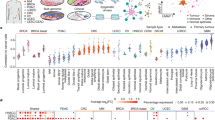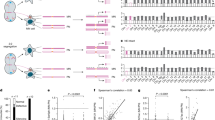Abstract
Genetic and epigenetic alterations have been identified that lead to transcriptional deregulation in cancers. Genetic mechanisms may affect single genes or regions containing several neighboring genes, as has been shown for DNA copy number changes. It was recently reported that epigenetic suppression of gene expression can also extend to a whole region; this is known as long-range epigenetic silencing. Various techniques are available for identifying regional genetic alterations, but no large-scale analysis has yet been carried out to obtain an overview of regional epigenetic alterations. We carried out an exhaustive search for regions susceptible to such mechanisms using a combination of transcriptome correlation map analysis and array CGH data for a series of bladder carcinomas. We validated one candidate region experimentally, demonstrating histone methylation leading to the loss of expression of neighboring genes without DNA methylation.
This is a preview of subscription content, access via your institution
Access options
Subscribe to this journal
Receive 12 print issues and online access
$209.00 per year
only $17.42 per issue
Buy this article
- Purchase on Springer Link
- Instant access to full article PDF
Prices may be subject to local taxes which are calculated during checkout






Similar content being viewed by others
Accession codes
Change history
27 February 2008
In the version of this article initially published, the horizontal dashed lines representing the threshold value in the panels in row b of Figures 2 and 4 were incorrectly placed. The errors have been corrected in the HTML and PDF versions of this article.
References
Solinas-Toldo, S. et al. Matrix-based comparative genomic hybridization: biochips to screen for genomic imbalances. Genes Chromosom. Cancer 20, 399–407 (1997).
Pinkel, D. et al. High resolution analysis of DNA copy number variation using comparative genomic hybridization to microarrays. Nat. Genet. 20, 207–211 (1998).
Hughes, T.R. et al. Widespread aneuploidy revealed by DNA microarray expression profiling. Nat. Genet. 25, 333–337 (2000).
Hyman, E. et al. Impact of DNA amplification on gene expression patterns in breast cancer. Cancer Res. 62, 6240–6245 (2002).
Pollack, J.R. et al. Microarray analysis reveals a major direct role of DNA copy number alteration in the transcriptional program of human breast tumors. Proc. Natl. Acad. Sci. USA 99, 12963–12968 (2002).
Masayesva, B.G. et al. Gene expression alterations over large chromosomal regions in cancers include multiple genes unrelated to malignant progression. Proc. Natl. Acad. Sci. USA 101, 8715–8720 (2004).
Heidenblad, M. et al. Microarray analyses reveal strong influence of DNA copy number alterations on the transcriptional patterns in pancreatic cancer: implications for the interpretation of genomic amplifications. Oncogene 24, 1794–1801 (2005).
Crawley, J.J. & Furge, K.A. Identification of frequent cytogenetic aberrations in hepatocellular carcinoma using gene-expression microarray data. Genome Biol. 3, RESEARCH0075 (2002).
Zhou, Y. et al. Genome-wide identification of chromosomal regions of increased tumor expression by transcriptome analysis. Cancer Res. 63, 5781–5784 (2003).
Kano, M. et al. Expression imbalance map: a new visualization method for detection of mRNA expression imbalance regions. Physiol. Genomics 13, 31–46 (2003).
Midorikawa, Y. et al. Distinct chromosomal bias of gene expression signatures in the progression of hepatocellular carcinoma. Cancer Res. 64, 7263–7270 (2004).
Furge, K.A., Dykema, K.J., Ho, C. & Chen, X. Comparison of array-based comparative genomic hybridization with gene expression-based regional expression biases to identify genetic abnormalities in hepatocellular carcinoma. BMC Genomics 6, 67 (2005).
Yang, X.J. et al. A molecular classification of papillary renal cell carcinoma. Cancer Res. 65, 5628–5637 (2005).
Fujii, T. et al. A preliminary transcriptome map of non-small cell lung cancer. Cancer Res. 62, 3340–3346 (2002).
Cohen, B.A., Mitra, R.D., Hughes, J.D. & Church, G.M. A computational analysis of whole-genome expression data reveals chromosomal domains of gene expression. Nat. Genet. 26, 183–186 (2000).
Spellman, P.T. & Rubin, G.M. Evidence for large domains of similarly expressed genes in the Drosophila genome. J. Biol. 1, 5 (2002).
Reyal, F. et al. Visualizing chromosomes as transcriptome correlation maps: evidence of chromosomal domains containing co-expressed genes–a study of 130 invasive ductal breast carcinomas. Cancer Res. 65, 1376–1383 (2005).
Yi, Y., Mirosevich, J., Shyr, Y., Matusik, R. & George, A.L., Jr . Coupled analysis of gene expression and chromosomal location. Genomics 85, 401–412 (2005).
Frigola, J. et al. Epigenetic remodeling in colorectal cancer results in coordinate gene suppression across an entire chromosome band. Nat. Genet. 38, 540–549 (2006).
Turner, B.M. Cellular memory and the histone code. Cell 111, 285–291 (2002).
Nguyen, C.T. et al. Histone H3-lysine 9 methylation is associated with aberrant gene silencing in cancer cells and is rapidly reversed by 5-aza-2'-deoxycytidine. Cancer Res. 62, 6456–6461 (2002).
Daigo, Y. et al. Molecular cloning of a candidate tumor suppressor gene, DLC1, from chromosome 3p21.3. Cancer Res. 59, 1966–1972 (1999).
Nakamura, Y. et al. Phospholipase Cdelta1 is required for skin stem cell lineage commitment. EMBO J. 22, 2981–2991 (2003).
Chambeyron, S. & Bickmore, W.A. Chromatin decondensation and nuclear reorganization of the HoxB locus upon induction of transcription. Genes Dev. 18, 1119–1130 (2004).
Huebert, D.J. & Bernstein, B.E. Genomic views of chromatin. Curr. Opin. Genet. Dev. 15, 476–481 (2005).
Gialitakis, M. et al. Coordinated changes of histone modifications and HDAC mobilization regulate the induction of MHC class II genes by trichostatin A. Nucleic Acids Res. 34, 765–772 (2006).
Bird, A. DNA methylation patterns and epigenetic memory. Genes Dev. 16, 6–21 (2002).
van Driel, R., Fransz, P.F. & Verschure, P.J. The eukaryotic genome: a system regulated at different hierarchical levels. J. Cell Sci. 116, 4067–4075 (2003).
Zardo, G. et al. Integrated genomic and epigenomic analyses pinpoint biallelic gene inactivation in tumors. Nat. Genet. 32, 453–458 (2002).
Hurst, L.D., Pal, C. & Lercher, M.J. The evolutionary dynamics of eukaryotic gene order. Nat. Rev. Genet. 5, 299–310 (2004).
Sproul, D., Gilbert, N. & Bickmore, W.A. The role of chromatin structure in regulating the expression of clustered genes. Nat. Rev. Genet. 6, 775–781 (2005).
Chang, H.Y. et al. Gene expression signature of fibroblast serum response predicts human cancer progression: similarities between tumors and wounds. PLoS Biol. 2, E7 (2004).
Diez de Medina, S.G. et al. Decreased expression of keratinocyte growth factor receptor in a subset of human transitional cell bladder carcinomas. Oncogene 14, 323–330 (1997).
Chirgwin, J.M., Przybyla, A.E., MacDonald, R.J. & Rutter, W.J. Isolation of biologically active ribonucleic acid from sources enriched in ribonuclease. Biochemistry 18, 5294–5299 (1979).
Coombs, L.M. et al. Simultaneous isolation of DNA, RNA, and antigenic protein exhibiting kinase activity from small tumor samples using guanidine isothiocyanate. Anal. Biochem. 188, 338–343 (1990).
Labarca, C. & Paigen, K. A simple, rapid, and sensitive DNA assay procedure. Anal. Biochem. 102, 344–352 (1980).
Snijders, A.M. et al. Genome-wide-array-based comparative genomic hybridization reveals genetic homogeneity and frequent copy number increases encompassing CCNE1 in fallopian tube carcinoma. Oncogene 22, 4281–4286 (2003).
Jain, A.N. et al. Fully automatic quantification of microarray image data. Genome Res. 12, 325–332 (2002).
Neuvial, P. et al. Spatial normalization of array-CGH data. BMC Bioinformatics 7, 264 (2006).
Hupé, P., Stransky, N., Thiery, J.P., Radvanyi, F. & Barillot, E. Analysis of array CGH data: from signal ratio to gain and loss of DNA regions. Bioinformatics 20, 3413–3422 (2004).
Southgate, J., Hutton, K.A., Thomas, D.F. & Trejdosiewicz, L.K. Normal human urothelial cells in vitro: proliferation and induction of stratification. Lab. Invest. 71, 583–594 (1994).
Xiong, Z. & Laird, P.W. COBRA: a sensitive and quantitative DNA methylation assay. Nucleic Acids Res. 25, 2532–2534 (1997).
O'Neill, L.P. & Turner, B.M. Immunoprecipitation of native chromatin: NChIP. Methods 31, 76–82 (2003).
Kent, W.J. BLAT–the BLAST-like alignment tool. Genome Res. 12, 656–664 (2002).
R development core team R: a Language and Environment for Statistical Computing. (R Foundation for Statistical Computing, Vienna, 2006).
Acknowledgements
We thank C. Rouveirol for discussions, P. Hupé for his GLAD algorithm expertise and the Institut Curie Bioinformatics Service headed by E. Barillot for support. We also thank J. Sappa from Alex Edelman & Associates for careful reading of the manuscript and the UCSF Cancer Center Array CGH Core for providing the BAC arrays. This article is dedicated to the memory of D. Chopin, whose commitment to cancer research was of paramount importance for the initiation of this work. This work was supported by the CNRS, the Institut Curie, AstraZeneca, the Canceropole Ile de France and the Ligue Nationale Contre le Cancer. N.S., C.V., F. Reyal, I.B.-P., S.G.D. de M. and F. Radvanyi are members of the Equipe Oncologie Moléculaire, labellisée par La Ligue Nationale Contre le Cancer. N.S. was supported by a fellowship from the French Ministry of Education and Research and a fellowship from the Association pour la Recherche sur le Cancer. C.V. was supported by a fellowship from the French Ministry of Education and Research and F. Reyal by a fellowship from the Ligue Nationale Contre le Cancer.
Author information
Authors and Affiliations
Corresponding author
Ethics declarations
Competing interests
The authors declare no competing financial interests.
Supplementary information
Supplementary Fig. 1
Transcriptome correlation maps of all chromosomes for the 57 bladder carcinomas. (PDF 1711 kb)
Supplementary Fig. 2
Quantitative PCR analysis of the gene copy number of region 3-2. (PDF 33 kb)
Supplementary Table 1
Transcriptome correlation map of 57 bladder carcinomas for chromosomes 1 to X (PDF 130 kb)
Supplementary Table 2
Clinical data of the 57 bladder carcinomas. (PDF 42 kb)
Supplementary Table 3
Primers for quantitative PCR, COBRA and ChIP experiments. (PDF 45 kb)
Rights and permissions
About this article
Cite this article
Stransky, N., Vallot, C., Reyal, F. et al. Regional copy number–independent deregulation of transcription in cancer. Nat Genet 38, 1386–1396 (2006). https://doi.org/10.1038/ng1923
Received:
Accepted:
Published:
Issue Date:
DOI: https://doi.org/10.1038/ng1923
This article is cited by
-
Dynamics of genome architecture and chromatin function during human B cell differentiation and neoplastic transformation
Nature Communications (2021)
-
Inhibition of the CCL2 receptor, CCR2, enhances tumor response to immune checkpoint therapy
Communications Biology (2020)
-
High expression of OSR1 as a predictive biomarker for poor prognosis and lymph node metastasis in breast cancer
Breast Cancer Research and Treatment (2020)
-
Latent network-based representations for large-scale gene expression data analysis
BMC Bioinformatics (2019)
-
IGF1R activation and the in vitro antiproliferative efficacy of IGF1R inhibitor are inversely correlated with IGFBP5 expression in bladder cancer
BMC Cancer (2017)



